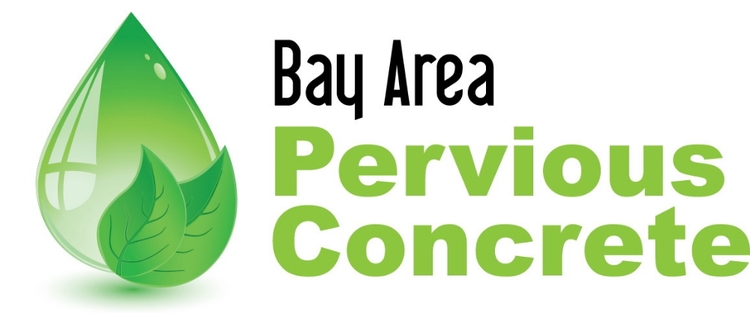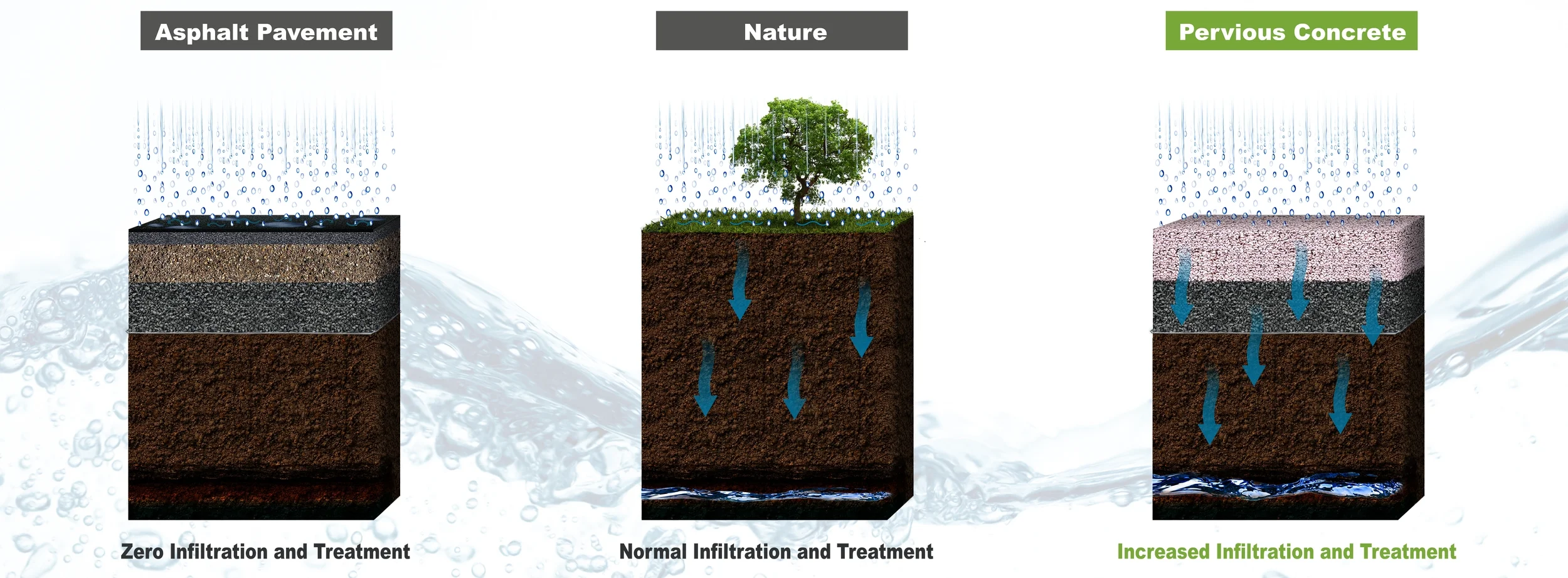How it Works
Pervious concrete is a durable concrete pavement with a large volume (approx. 20%) of interconnected voids. Like conventional concrete, it is made from a mixture of cement, coarse aggregates, and water. However, it contains little or no sand, which results in a porous open-cell structure that allows water passes through readily.
When pervious concrete is used for paving, it can take in storm water at a rate of several hundred or more inches of water per square foot per hour, which far exceeds the flow rate needed to prevent runoff in even the most severe rain events.
In slow draining type C & D clay soils, rainwater is temporarily stored in a coarse gravel layer underneath the pavement while it is allowed to naturally percolate slowly into the underlying soil. Because the pavement and base layer act as a detention area to capture and infiltrate water, it can completely prevent the polluted site runoff that normally occurs with impervious pavements. Properly designed the pervious concrete system can eliminate the cost of the conventional storm water infrastructure with no need for bio-swales or rain gardens.
Pervious concrete pavement systems are fully recognized as an EPA Storm water BMP which fully complies with the San Francisco regional stormwater Provision C.3 for both infiltration and treatment. As the water percolates through the open cells of the pavement and crushed rock base layer aerobic bacteria in the voids help to break down harmful pollutants and chemicals.
At Bay Area Pervious Concrete, we have proprietary mix designs that we use to customize pervious concrete for the variable conditions found throughout the San Francisco Bay Area. We can design the optimal mix design for your site and application. Contact us for more information.
Maximize Property Value
Are you faced with losing valuable areas of your property to rain gardens, bio-swales or detention ponds? Are you considering the enormous expense of underground tanks? Frustrated because local stormwater regulations are impacting your property in terms of both site design and costs? Looking for a straight forward, cost effective, comprehensive solution that gives you back control of your property? Well look no more, we've got you covered.
Why Manage Stormwater Runoff, When You Can Eliminate It
Pervious concrete is a muti-purpose pavement. Unlike conventional asphalt or concrete pavements which create stormwater runoff, pervious concrete provides hard and durable, vehicle or pedestrian, surface while also doubling as your passive storm water management system. A properly designed system has no runoff to manage, 100% of the water that falls on it infiltrates through it. Removing the need for additional single-purpose infiltration and treatment devices, drainage pipes, curbs, gutters and slopes that reduce the amount of developable land and add to project costs.
Roof Run-Off
Maximize the performance of your stormwater capture system by using the pervious concrete system to also infiltrate stormwater from adjacent roofs. By infiltrating 100% of on-site stormwater you can eliminate costs on other traditional stormwater infrastructure. The soil infiltration rate, design storm and pavement/roof area ratio will determine how much you can capture. In many cases 100% of the roof area can be handled by the pervious concrete system using a principle known as LATIS.
Stormwater Super Power: LATIS
This super power is a result of a principle known as LATIS, or "Large Area Thin Infiltration System". Conventional stormwater systems take water from large impervious areas and concentrates it into a smaller but much deeper footprint, while a LATIS keeps the water spread out and shallow. Dealing with only a few inches of rain water vs. several feet in a pond has a significant positive impact on performance, particularly with low infiltrating clay soils. Want to know more, check out the LATIS info.
Reduce Project Costs
Simplify stormwater system design
When the hardscape functions as both an infiltration and treatment device, conventional stormwater systems including detention ponds, bio-swales, flow-through-planters, infiltration trenches, and filtration devices are no longer required.
Eliminating surface water flow, or the need to transport water to another location for treatment, also eliminates the need for drainage pipes, curbs, gutters and slopes. Water simply stays where it falls and soaks in under the slab.
The simplicity of a pervious concrete stormwater system means spending less time designing.
Increase cost effectiveness of your stormwater system design
Pervious concrete is a multi-purpose hardscape - tripling as a pavement, infiltration and treatment device. Allowing you to use all the project's required hardscape as the stormwater treatment system.
Meet municipal stormwater regulations, without adding additional costs or infrastructure.
Increased Pavement longevity and reduce maintenance costs
Properly designed systems perform at high levels with little or no maintenance. In most situations removing surface debris with a leaf-blower is all that is required.
Pervious concrete (like all concrete products) pavements last 2-3 times longer than asphalt and do not require regular re-coating, resulting in significantly lower Life Cycle Costs.
Pervious concrete allows for expansive soils to absorb water and expand evenly across the area of the slab, unlike conventional concrete where more water infiltrates only along perimeter than the center causing differential expansion of the soil leading to cracks.
With the increase in water and air flow into surrounding soil, trees grown near pervious concrete thrive.
Increase Resiliency
Municipalities are beginning to focus not on just infiltration of stormwater to help with flood control, but also on-site treatment of stormwater to reduce pollution in local waterways. Unlike many BMPs pervious concrete is approved by the EPA as both an infiltration and treatment device, one that eliminates the need for any other water treatment measures. Read below to see just how environmentally beneficial it is to use pervious concrete.
Native Hydrology
Fundamentally, what is most exciting about pervious concrete, is that we are returning land to a pre-developed hydrology, while maintaining the useful hard surface that we prefer to live, work, play and drive on. The rain that falls can again soak into the ground it landed on instead of flowing across a hardscape, picking up contaminants, and getting sent through pipes to the nearest body of water. In cases where native soils may infiltrate slowly or quickly saturate creating runoff, pervious concrete can outperform nature for the amount of stormwater it can infiltrate and treat, thus providing increased hydrological benefits.
Removes Pollution
When rain soaks into the ground, not only does it re-charge, or re-fill, the groundwater and local aquifers, but it also filters out the stormwater contaminants. Instead of picking up the pollution and sweeping it into surface streams and finally the ocean, the pervious concrete and native soil filter out the heavy metals, hydrocarbons, and other pollutants passively. Studies have shown that pervious concrete systems remove 94-100% of all stormwater pollutants. In this way, we remove the biggest pollution source of our freshwater in North America in a very affordable way!
Cool Pavement
Pervious concrete is a cooler pavement than traditional pavements. The air and water exchange from the surface of the pavement to the sub-soil beneath keeps the pervious concrete slab cooler. Studies have shown that trees and landscaping thrive with pervious concrete due to this and other effects. This also reduces the heat island effect of dense development.
Recycled and Local Materials
Pervious concrete is composed of cement, local aggregate and water, with optional ad-mixtures. It can be made using industry by-products like fly ash, slag, micro silica and recycled aggregate, thus increasing its recycled content and lowering its Life Cycle Cost.
Water Recapture
When planning for landscaping, it is possible both to leverage the porosity of the pervious concrete as a means of capturing irrigation water. It also provides a way to pave safely closer to existing trees without starving them of necessary air and water, increasing usable hardscape area. Trees planted in pervious concrete plots have been shown to experience a growth rate that was 68% greater than that of trees in traditional concrete plots.
Reduce Embodied Energy and Carbon
Reducing embodied energy and carbon are considered key priorities in the goal to reduce climate change. The consumption of portland cement, a key ingredient to concrete, accounts for 5% of all human-generated carbon emissions annually. Pervious concrete uses less portland cement per volume than conventional concrete, and can reduce a pavement's embodied carbon by almost 40%. The additions of industry by-products produces a 64% reduction of embodied carbon per volume. When compared to asphalt, pervious concrete requires less energy to be produced, leading to a 56-70% reduction in embodied energy at the time of installation.
Green Credits
Due to these attributes, pervious concrete qualifies for credits with LEED, Living Building Challenge, CAL Green and Green Point Rated systems. For LEED, pervious concrete can earn a project credits for Sustainable Sites, Recycled and Local Materials, Innovation in Design and Water Efficiency. If you would be interested in more information, contact us!



